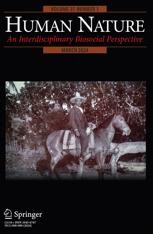Sex ratios and violence – more men does not mean more trouble
Study questions the value of “tough-on-crime” policies and high incarceration rates of men, creating an overabundance of women in some communities
Heidelberg | New York, 28 September 2016
 Conventional wisdom expects crime and violence to be elevated in communities with an excess of men. However, recent research published in Springer’s journal Human Nature, led by Ryan Schacht from the University of Utah in the US, directly challenges this intuition. In fact, crime statistics from more than 3,000 American counties show that rates of violence and criminal activity – from homicide to rape – are higher in populations with a deficit, not a surfeit, of men.
Conventional wisdom expects crime and violence to be elevated in communities with an excess of men. However, recent research published in Springer’s journal Human Nature, led by Ryan Schacht from the University of Utah in the US, directly challenges this intuition. In fact, crime statistics from more than 3,000 American counties show that rates of violence and criminal activity – from homicide to rape – are higher in populations with a deficit, not a surfeit, of men.
It is a cross-cultural universal that men are much more likely to be both the victims and the perpetrators of crime than women. In addition, men are much more likely than women to engage in violent competitions over sexual partners. Thus, an excess of males is thought to create a potential powder keg for social instability—both through the rising numbers of testosterone-fueled, unmarried men and the intensified conflict among them over the increasingly scarce women.
“However, although it is indeed true that men experience higher mortality rates and are more violence-prone than women, it is not true that a surplus of men will necessarily lead to a surplus of violence,” says Schacht.
His observations follow the analysis of crime data from 3,082 US counties, boroughs and parishes in the Federal Bureau of Investigation’s 2010 Uniform Crime Reporting Program. The research includes data on rates of murder, aggravated assault, sex offenses, rape and prostitution in each area. These measures of crime were used to evaluate the intensity of violent competition between men as well as their engagement in uncommitted sexual behavior.
In counties with a surplus of women, men’s pursuit of partners was found to result in violence between males through elevated rates of homicide and aggravated assault. These findings highlight Schacht and colleagues’ supply-and-demand approach to understanding relationships—that is, where men are rare and potential partners abundant, men are expected to be more likely to pursue short-term sexual relationships. They show that when men are exposed to a glut of potential partners, they are more likely to engage in direct, violent competition with other men over women. Furthermore, rates of criminal behavior associated with uncommitted sex (e.g., prostitution) were higher in counties with more women than men.
“Rates of mating-effort-related crime and violence are highest when men are relatively scarce,” Schacht summarizes. “Accordingly, our results highlight the need to pay increased attention to female-biased sex ratios—which are often, and unfortunately, overlooked.”
Schacht argues that these results raise concerns about the “tough-on-crime” policies used in highly policed areas of the United States. These procedures lead to high numbers of men being jailed in specific communities but in the process create extremely skewed, female-biased areas.
“Following our findings, these policies likely only exacerbate the very types of criminal and violent behavior they are attempting to alleviate,” adds Schacht.
Reference: Schacht, R., Tharp, D., Smith, K.R. (2016). Marriage Markets and Male Mating Effort: Violence and Crime Are Elevated Where Men Are Rare, Human Nature. DOI 10.1007/s12110-016-9271-x
Further Information
About the journal Human Nature
Services for Journalists
The full-text article is available to journalists on request.
Contact
Joan Robinson | Springer Nature | Communications
tel +49 6221 487 8130 | joan.robinson@springer.com
